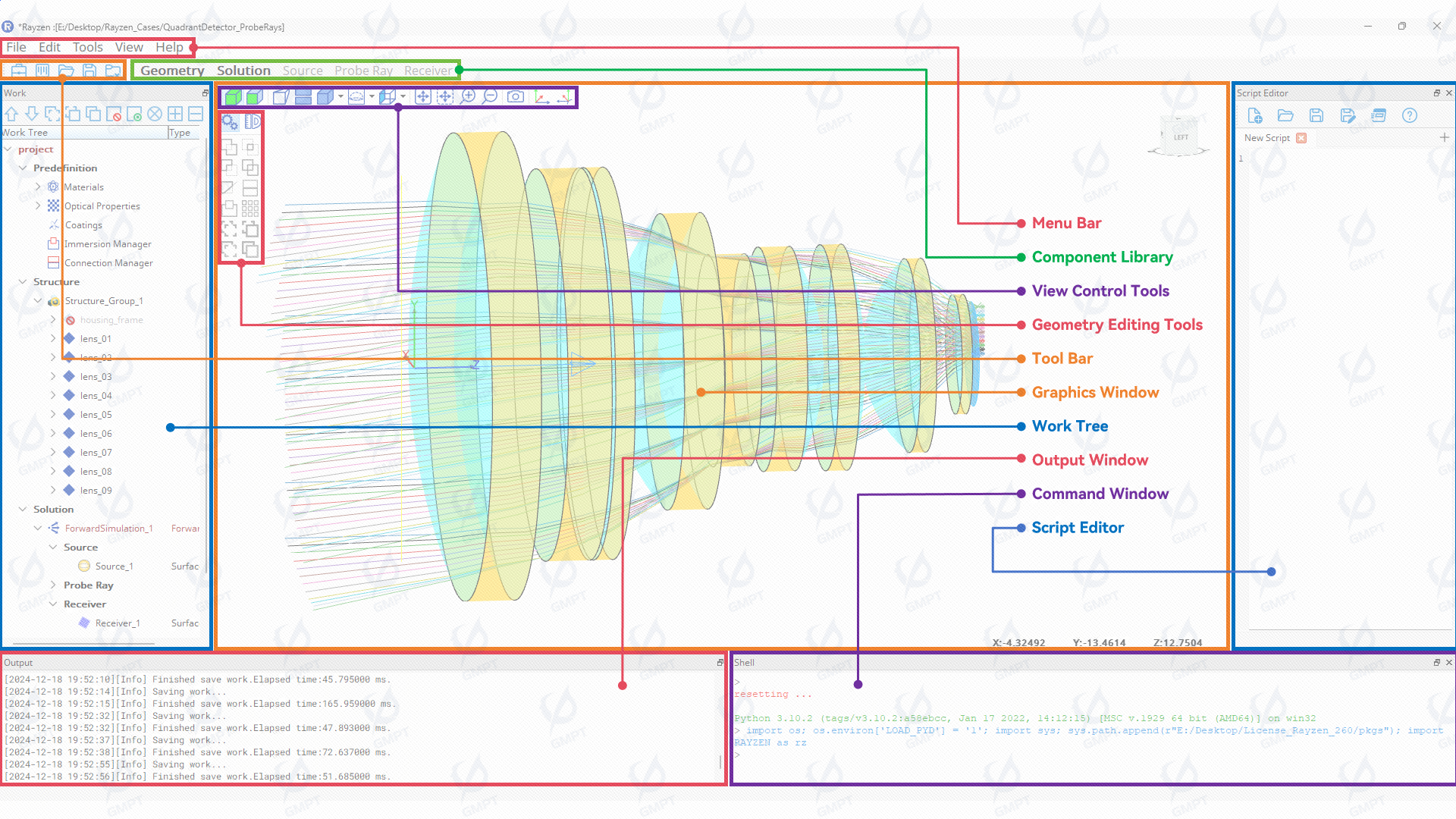Optical System Simulation Software - Rayzen Product Introduction
GMPT, October 2024
Software Introduction
Rayzen is a specialized tool designed for the simulation and design of optical systems, leveraging low-discrepancy sequence Monte Carlo methods, non-sequential forward ray tracing, and expert CAD engine. These advanced techniques enable a detailed analysis of light propagation paths, refraction, reflection, and scattering behaviors within complex optical systems. The software analyzes surface morphology, optical properties of components, and material characteristics to accurately model how these factors influence light behavior.
Rayzen finds extensive application in the following areas:
- Stray Light Analysis in Imaging Systems: Investigating unwanted light paths that can degrade image quality.
- Illumination Distribution in Lighting Systems: Optimizing light distribution patterns for efficiency and desired effects.
- Light Transmission and Extraction in Collection and Guidance Systems: Enhancing the performance of systems designed to gather or direct light.
The software is an indispensable tool for research and development in various fields including imaging and non-imaging optical design, photonic components, photonics system integration, display panels, and optical thin films. Through its comprehensive capabilities, Rayzen supports researchers and engineers in achieving precise and innovative optical solutions.

Solver List
| Non-sequential Ray Tracing | Forward Tracing |
| *Backward Tracing | |
| *Hybrid Tracing | |
| *Sequential Ray Tracing | |
| *Tolerance Analysis | |
| *Optimization | |
Model List
| Material | Isotropic | Refractive Index | Single Value |
| Tabular Interpolation | |||
| Sellmeier | |||
| Cauchy | |||
| Conrady | |||
| Schott | |||
| Herzberger | |||
| Hartmann | |||
| Absorption | Absorption Coefficient vs. Wavelength | ||
| Extinction Coefficient vs. Wavelength | |||
| Transmittance/Length vs. Wavelength | |||
| Optical Density vs. Wavelength | |||
| Volume Scattering | Henyey-Greenstein | ||
| *Gegenbauer | |||
| *Mie | |||
| *Phosphor | |||
| *Birefringence | |||
| *Graded Refractive Index | |||
| Optical Properties | Ideal Smooth Surface | ||
| Scattering | Lambertian Scattering | ||
| Gaussian Scattering | |||
| CosN Scattering | |||
| Measured BSDF | |||
| *Abg | |||
| *Harvey-Shack | |||
| *Microfacet | |||
| *Grating | |||
| Light Sources | Virtual Light Sources | Point Source | |
| 2D Area Source | |||
| *Volume Source | |||
| *Data Source | |||
| *3D Area Source | |||
| *Physical Source | *3D Area Source with Additional Material and Optical Properties | ||
| Receivers | Surface Receiver (Planar) | ||
| *Surface Receiver (Curved) | |||
| Far-field Receiver | |||
Output Data Types
| Receiver Data | |
| Mesh Analysis | Illuminance |
| Intensity | |
| Luminance | |
| Ray Number | |
| Relative Power | |
| Color Differences | |
| RGB | |
| Tristimulus Values | |
| Chromaticity Coordinates | |
| Color Temperature | |
| Spectral Distribution | |
| Statistical Analysis Indicators | |
| Ray Path Data | |
Software Features
- High-precision Fast Simulation:
Leveraging unbiased random numbers, comprehensive sampling strategies, full surface treatment, and reliable geometric processing modules, Rayzen can achieve high-precision and fast simulation of optical systems. This helps accelerate product development and optimization cycles, enhancing work efficiency.
- Wide Application Areas:
Rayzen is widely used not only in imaging and non-imaging optics but also plays an important role in the EDA/TCAD industry. It can be applied in the development of optoelectronic components, photonic system integration, display panels, and optical films, providing professional support and solutions.
- Multi-Physics Coupled Simulation:
The seamless integration between Rayzen and Nuwa TCAD enables a smooth connection between ray optics simulation and drift-diffusion theory simulation.This enables more accurate simulations of semiconductor components by considering multiple physical fields such as electrical, optical, thermal, and mechanical, providing more comprehensive and accurate results.
Note: * represents features under development.